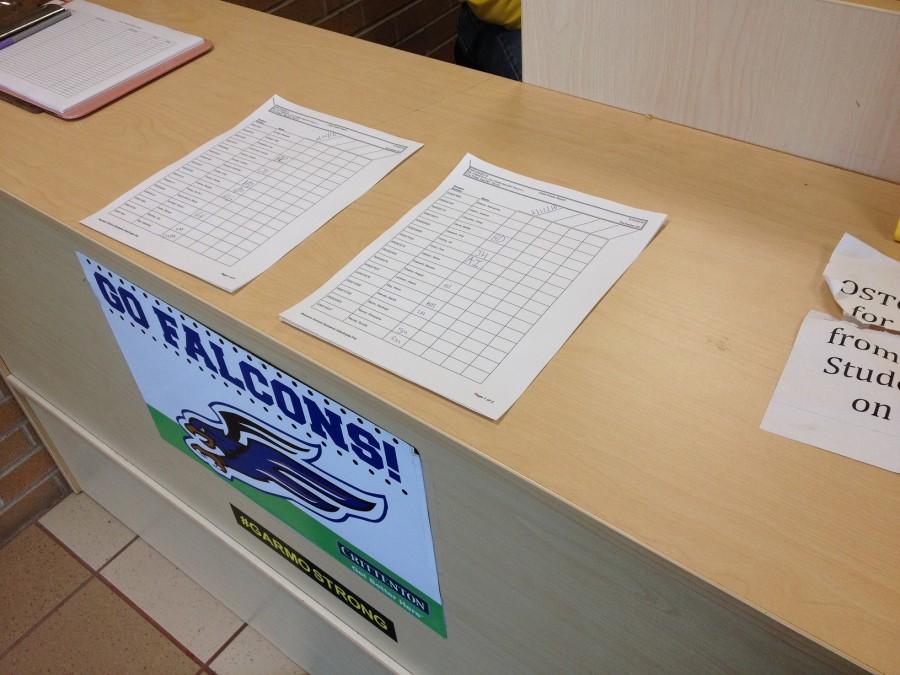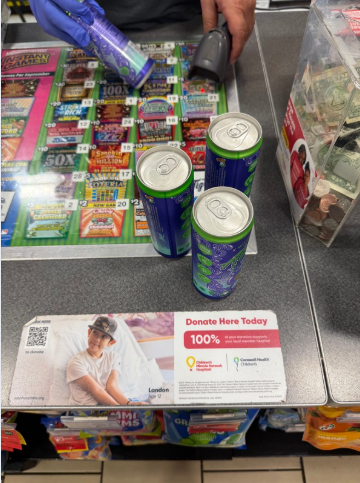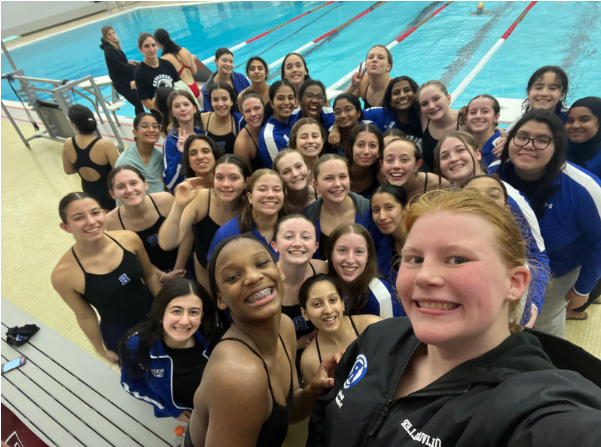Hybrid classes help students prepare for future
Students sign in at the security desk when the come in after a hybrid hour.
March 30, 2016
Junior Emily Schneider walks into school after first hour feeling well rested and prepared for her classes.
“I usually just sleep in a little bit,” Schneider said. “At least today I studied for my math test before math, but [I] just kind of relax.”
Schneider’s first hour class, German 4, allows her to stay at home for first hour once a week as a part of the technology-enhanced learning program. Hybrid-blended courses are one of the numerous ways in which students have the opportunity to learn in a new way.
“I think it’s good for the kids,” AP Studio Art teacher Mrs. Jessica Huvaere said. “I think it gives them a lot of flexibility in their schedule and it’s more like a college experience.”
French teacher Mrs. Elizabeth Arcangeli agrees that hybrid classes have a preparatory advantage.
“This model prepares students for how classes are taught at the college level,” Mrs. Arcangeli said. “Students will be expected to work independently and manage their time accordingly after high school.”
There are three hybrid classes currently offered at RHS: German 4/5AP, French 4/5AP and AP Studio Art. The hybrid aspect is applied differently to every class.
“For German, [before we had hybrid] when German 5 was doing doing stuff we would just have to sit there bored and listen or read articles, and now we don’t,” Schneider said. “We can do other stuff at home to be more productive and learn more instead of just being bored.”
For AP Studio Art, the hybrid gives students a chance to work on projects in a more continuous period of time.
“One hour [for] a serious advanced art student, is not enough time really, to get a significant chunk of work done on a project,” Mrs. Huvaere said. “A lot of the time, students are working on these big giant oil paintings that by the time they get set up, it’s time to clean up, so for them to get all their brushes and their paints out and start color mixing, and then class is over, and they’ve only been able to work on it for a half an hour, sometimes that’s not necessarily worth it.”
In AP Studio Art, students have the opportunity to choose whether or not they leave school.
“Half the kids stay and the others leave early,” Mrs. Huvaere said. “It’s almost a reward system too because if you’re staying up to date on your classwork and you’re getting all your projects done and turning things in when you’re supposed to, then you get to leave.”
In the French classes, students use this time to gain more interactive experiences with the language and culture.
“I use the hybrid model in lieu of lessons that would normally necessitate the language lab,” Mrs. Arcangeli said. “For example, students are able to watch videos, listen to dialogues, radio programs and answer questions about the content.”
Students generally like the prospect of having a hybrid hour.
“Since I have a hybrid first hour, I like not having to come in to school early and that I get an extra hour of sleep,” senior Lily Mackley said. “When my hybrid was sixth hour last year; I liked being able to leave school early and go home.”
However, from the teacher’s perspective, there is a negative side as well.
“As a teacher it creates much more work,” Mrs. Arcangeli said. “While I am working with half the class in my room, the other half has a Blended Day, which means I am creating two lessons and correcting twice as much work. It is worth it ultimately because students make more progress when they are in smaller groups.”
Art students lack the guidance of their teacher when producing works of art at home.
“Sometimes a student will go home and do this project, they’ll spend so much time on it, and all of a sudden I’ll catch some sort of a flaw that, had they been working in front of me, I could’ve maybe helped them to correct the piece as they were going,” Mrs. Huvaere said. “Sometimes that happens where [students] come back with something that’s totally finished [and] that I haven’t seen the steps along the way.”
Students do not see much of a downside to hybrid classes.
“There’s nothing too significant that I don’t like about having a hybrid class,” Mackley said. “If I decide to sleep in and come to school later then I have to park at the very end of the parking lot which isn’t the nicest walk in the snow.”
Schneider realizes that students in such classes have to go the extra mile and put in their own effort.
“You have to do work outside the classroom so you have to get that done instead of just depending on class time,” Schneider said.
Mackley agrees.
“Students who don’t do their hybrid day assignments do not do well in the class,” Mackley said. “Independent and responsible students excel in hybrid classes because you have to be able to manage your time efficiently in order to get your work done without a teacher reminding you.”
Mrs. Huvaere believes hybrid classes are catered to a certain group of students.
“It would be a hard class to run if you had students that were not in 11th and 12th grade because you have to be able to have a car and you have to be able to leave,” Mrs. Huvaere said. “And the responsibility comes with it. It’s really designed for a more mature student so you have to have that population.”
Similarly, Mrs. Arcangeli believes the students’ drive is the key to the success of a hybrid class.
“I think virtually any course could be made into a hybrid,” Mrs. Arcangeli said. “The success really lies in how responsible and motivated students are and how well constructed the lessons are on Blended Days.”







